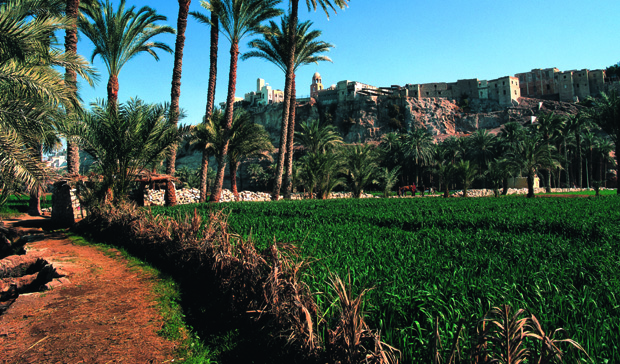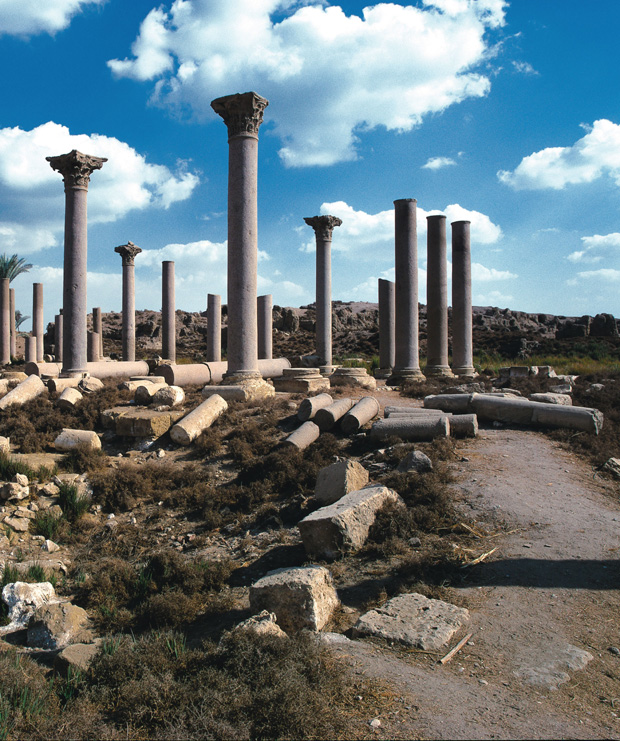Perched on a cliff, high above the east bank of the Nile, and not far north of Minya, lies the small Coptic church of the Holy Virgin at Gabal al-Tayr, also known as Gabal al-Kaff (‘Mountain of the Palm[-print]’).
It is said that the rock-cut church there was constructed in 328 on the orders of the Empress Helena — the mother of the Emperor Constantine — though it is likely that the church may have been a late antique tomb.
 A view of Gabal al-Tayr, from Ludwig: The Churches of Egypt (AUC Press).[/caption]
A view of Gabal al-Tayr, from Ludwig: The Churches of Egypt (AUC Press).[/caption]
Abu al-Makarim, a twelfth-century Coptic priest, says of the former monastery, “The church is hewn out of the mountain side, and in the rock is the mark of the palm of the hand of the Lord Christ which was made when he touched the mountain. … He grasped the mountain, when it worshipped before him, and restored it to its place with his hand, so that the mark of his palm remains impressed upon the mountain.”
The cave in which the Holy Family is reputed to have subsequently sheltered is still to be seen in the church, and the church attracts tens of thousands of pilgrims each year on the Feast of the Assumption (August 22).
The monastery at Gabal al-Tayr was one of the first to be associated, in this manner, with the tradition that the Holy Family travelled for several years within Egypt following their narrow escape from Judea.
The principal reference suggesting the presence of the Holy Family in Egypt is the oft-quoted passage in the Gospel of St. Matthew (2:13-23) in which the evangelist tells us that an angel appeared to Joseph and told him that Herod intended to kill the infant Jesus. He must gather up mother and child, the angel said, flee to Egypt, and stay there until the death of the king. Later in the passage, we are told that an angel appeared to Joseph in Egypt and informed him that it was safe to return home as Herod had died. After returning, the Holy Family settled at Nazareth in Galilee.
It is easy to understand that early Christians in Egypt were intensely interested in where this particular migrant family had visited during their exile, and while the extensive itineraries of places visited by the Holy Family were products of the twelfth century or later, it is reasonable to assume that they were influenced by oral traditions which predated them by many centuries.
The development of the idea that the Holy Family traveled widely in Egypt was greatly helped by the statement by the prolific early third-century theologian Hippolytus of Rome, that Jesus had stayed in Egypt for three and a half years as a child. Such a figure may, in part, have reflected early Egyptian stories Hippolytus may have heard in Rome from the great Egyptian theologian Origen of Alexandria.
Though we cannot know when or where the first oral traditions associated with the Holy Family in Egypt began, the first written accounts are associated with another place not very far from Minya: the ancient city of Hermopolis Magna (modern al-Ashmunayn). In antiquity, Hermopolis had been associated with the god Thoth, but in the latter part of the third century it became an important Christian center.
 The basilica at Hermopolis Magna (al-Ashmunayn), from Ludwig: The Churches of Egypt (AUC Press).[/caption]
The basilica at Hermopolis Magna (al-Ashmunayn), from Ludwig: The Churches of Egypt (AUC Press).[/caption]
Around the year 400, an anonymous author described the journey of seven pilgrims from Palestine who toured monastic sites in Egypt during 394-95, including a stop at Hermopolis. Here they were told about the passing of the Holy Family and were taken to see where the statues of the ancient temples had been shaken and had fallen to the ground at the Christ child’s passing. Not only does this provide us with the earliest known written account of the presence of the Holy Family in Egypt, but it also gives us a fascinating insight into how the early church re-interpreted the remains of the pharaonic past all around it within a firmly Christian context.
From Hermopolis, the Holy Family tradition appears to have spread to other sites in Upper Egypt, including Gabal al-Tayr, and to Lower Egypt (Cairo, northern Sinai, and the Nile Delta). Indeed, by the twelfth century it was possible for Coptic writers to begin to connect all the sites in Egypt said to have been visited by the Holy Family, a process continued into the modern era.
Yet, whatever history might (or might not) tell us, as one takes in the timeless view over the Nile from the cliff at Gabal al-Tayr — or a hundred other sites in Egypt — it is impossible not to be absorbed into this wonderful tradition and imagine the presence of the Holy Family in those far-off days.
Note: I consulted a number of AUC Press titles while writing this brief essay, including the comprehensive Be Thou There: The Holy Family’s Journey in Egypt— especially the excellent chapter on ancient sources by Stephen J. Davis—which is currently out of print. For more general discussions of Christianity in Egypt, I recommend Gabra: Coptic Civilization; Ludwig: The Churches of Egypt; and the recently reprinted Meinardus: Two Thousand Years of Coptic Christianity.
Nigel Fletcher-Jones is director of the American University in Cairo Press. Join Nigel at facebook.com/aucpress. To find your closest AUC Press Bookstore, browse their list of stores at aucpress.com.
Comments
Leave a Comment